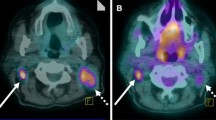Abstract
The scientific basis of nuclear medicine is the radiotracer, with its union of a pharmaceutical and a radionuclide. There are a number of existing tracers approved for use in the United States and elsewhere, but by far the most commonly used (and the only one used for melanoma and sarcoma) is fluorodeoxyglucose (FDG). FDG is a positron emitter, with the emitted positron being annihilated and producing two photons detected by the ring of detectors in the PET scanner. The PET is done together with a CT scan, which is used for both anatomic localization and attenuation correction. FDG is selectively taken up by cancer cells due to their heavy anaerobic metabolism, though other causes such as inflammation can also produce an increase in uptake. Common alterations in biodistribution include elevated glucose levels and/or insulin secretion and brown fat activation. The SUV (standardized uptake value) has been created as a semiquantitative measure of local uptake, correlates with prognosis, and is sometimes used for therapy assessment, but has technical problems resulting in significant variability.
Access this chapter
Tax calculation will be finalised at checkout
Purchases are for personal use only
Similar content being viewed by others
References
Mettler FA, Guiberteau MJ. Radioactivity, radionuclides, and radiopharmaceuticals. In: Essentials of nuclear medicine. 7th ed. Philadelphia: Elsevier; 2019. p. 1–18.
Mettler FA, Guiberteau MJ. Hybrid PET/CT neoplasm imaging. In: Essentials of nuclear medicine. Philadelphia: Elsevier; 2019. p. 328–61.
Mettler FA, Guiberteau MJ. Instrumentation and quality control. In: Essentials of nuclear medicine. 7th ed. Philadelphia: Elsevier; 2019. p. 19–59.
Macpherson RE, Pratap S, Tyrrell H, Khonsari M, Wilson S, Gibbons M, et al. Retrospective audit of 957 consecutive (18)F-FDG PET-CT scans compared to CT and MRI in 493 patients with different histological subtypes of bone and soft tissue sarcoma. Clin Sarcoma Res. 2018;8:9.
Burger IA, Huser DM, Burger C, von Schulthess GK, Buck A. Repeatability of FDG quantification in tumor imaging: averaged SUVs are superior to SUVmax. Nucl Med Biol. 2012;39(5):666–70.
Schmitt RJ, Kreidler SM, Glueck DH, Amaria RN, Gonzalez R, Lewis K, et al. Correlation between early 18F-FDG PET/CT response to BRAF and MEK inhibition and survival in patients with BRAF-mutant metastatic melanoma. Nucl Med Commun. 2016;37(2):122–8.
Zukotynski K, Yap JT, Giobbie-Hurder A, Weber J, Gonzalez R, Gajewski TF, et al. Metabolic response by FDG-PET to imatinib correlates with exon 11 KIT mutation and predicts outcome in patients with mucosal melanoma. Cancer Imaging. 2014;14:30.
Malik D, Sood A, Mittal BR, Basher RK, Bhattacharya A, Singh G. Role of (18)F-fluorodeoxyglucose positron emission tomography/computed tomography in restaging and prognosis of recurrent melanoma after curative surgery. World J Nucl Med. 2019;18(2):176–82.
Kang S, Ahn BC, Hong CM, Song BI, Lee HJ, Jeong SY, et al. Can (18)F-FDG PET/CT predict recurrence in patients with cutaneous malignant melanoma? Nuklearmedizin. 2011;50(3):116–21.
Son SH, Kang SM, Jeong SY, Lee SW, Lee SJ, Lee J, et al. Prognostic value of volumetric parameters measured by pretreatment 18F FDG PET/CT in patients with cutaneous malignant melanoma. Clin Nucl Med. 2016;41(6):e266–73.
Hwang JP, Lim I, Kong CB, Jeon DG, Byun BH, Kim BI, et al. Prognostic value of SUVmax measured by pretreatment Fluorine-18 fluorodeoxyglucose positron emission tomography/computed tomography in patients with Ewing sarcoma. PLoS One. 2016;11(4):e0153281.
Kubo T, Furuta T, Johan MP, Ochi M. Prognostic significance of (18)F-FDG PET at diagnosis in patients with soft tissue sarcoma and bone sarcoma; systematic review and meta-analysis. Eur J Cancer. 2016;58:104–11.
Chen L, Wu X, Ma X, Guo L, Zhu C, Li Q. Prognostic value of 18F-FDG PET-CT-based functional parameters in patients with soft tissue sarcoma: a meta-analysis. Medicine (Baltimore). 2017;96(6):e5913.
Author information
Authors and Affiliations
Corresponding author
Editor information
Editors and Affiliations
Rights and permissions
Copyright information
© 2021 Springer Nature Switzerland AG
About this chapter
Cite this chapter
Oldan, J.D., Ivanovic, M., Khandani, A.H. (2021). What Is Positron Emission Tomography?. In: Khandani, A.H. (eds) PET/CT and PET/MR in Melanoma and Sarcoma. Springer, Cham. https://doi.org/10.1007/978-3-030-60429-5_1
Download citation
DOI: https://doi.org/10.1007/978-3-030-60429-5_1
Published:
Publisher Name: Springer, Cham
Print ISBN: 978-3-030-60428-8
Online ISBN: 978-3-030-60429-5
eBook Packages: MedicineMedicine (R0)




